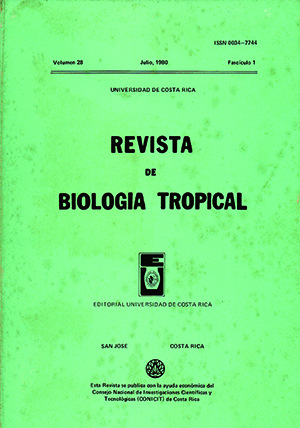Resumen
En Panamá los frutos del árbol de almendro Dipteryx panamensis maduran al comenzar la temporada seca, época que coincide con la escasez de otros tipos de frutas comestibles. En la Isla de Barro Colorado hay 16 especies de mamíferos que se alimentan de estas frutas o de las semillas. Estos animales, por sus hábitos, pueden clasificarse en 4 categorías: parásitos, depredadores, agentes de dispersión y comensales del árbol de almendro. Los roedores y los pecaríes destruyen muchas semillas, sin embargo, el 60% de éstas germina siempre que el embrión esté intacto. Los murciélagos, los primates y algunos roedores, quienes comen solamente la fruta, son los principales agentes de dispersión.
Citas
Bonaccorso, F.J. 1979. Foraging and reproductive ecology of a community of bats in Panama. Bull. Fla. St. Mus., Biol. Sci., 24: 359-408.
Chapman, F. M. 1938. Life in an air castle. Appleton-Century, New York, 250 p.
Cruz, A. 1974. Feeding assemblages of Jamaican birds. Condor, 76: 103-107.
Diamond, J.M. 1973. Distributional ecology of New Guinea birds. Science, 179: 759-769.
Diamond, J.M., & J.W. Terborgh. 1967. Observations on bird distribution and feeding assemblages along the Rio Callaria, Department of Lorento, Peru. Wilson Bull., 79: 273-282.
Downhower, J.F., & C.H. Racine. 1976. Darwin's finches and Croton scouleri: an analysis of the consequences of seed predation. Biotropica, 8: 66-77.
Duke, J.A. 1967. Mammal Dietary. Battelle Laboratories (Mimeographed).
Eisenman, E. 1961. Favorite foods of neotropical birds: flying termites and Cecropia catkins. Auk, 78: 636-638.
Fleming, T.H., E.R. Heithaus, & W.B. Sawyer. 1977. An experimental analysis of the food location behavior of frugivorous bats. Ecology, 58: 619-627.
Foster, R.B. 1973. Seasonality of fruit production and seedfall in a tropical forest ecosystem in Panama. Ph.D. Disst., Duke Univ., Durhm, N.C., 156 p.
Frankie, G.W., H.G. Baker, & P.A. Opler. 1974. Comparative phenological studies of trees in Tropical Wet and Dry Forests in the lowlands of Costa Rica. J. Ecol., 62: 881-919.
Goodwin, G.G., & A.M. Greenhall. 1961. A review of the bats of Trinidad and Tobago. Bull. Amer. Mus. Nat. Hist., 122: 191-304.
Heaney, L.R., & R.W. Thorington, Jr. 1978. Ecology of Neotropical redtailed squirrels, Sciurus granatensis, in the Panamá Canal Zone. J. Mamm., 59: 846-851.
Heithaus, E.R., P.A. Opler, & H.G. Baker. 1974. Bat activity and pollination of Bauhinia pauletia: plant-pollinator coevolution. Ecology, 55: 412-419.
Hladik, A., M. Hladik, J. Bousett, P. Valdebouze, G. Viroben, & J. Deloit-Laval. 1971. Le régime alimentaire de primates de l'Ile de Barro Colorado (Panama). Folia primatologia, 16: 95-122.
Holdridge, L.H. 1967. Life Zone Ecology. Tropical Science Center, San José, Costa Rica, 206 p.
Holdridge, L.H. 1970. Panama: inventariación y demostraciones forestales. Programa de Las Naciones Unidas para ei desarrollo . Panamá, 325 p.
Howe, H.F. 1977. Bird activity and seed dispersal of a tropical wet forest tree. Ecology, 58: 539-550.
Howe, H.F., & R.B. Primack. 1975. Differential seed dispersal by birds of the tree Casearia nitida (Flacourtiaceae). Biotropica, 7: 278-283.
Humphrey, S.R., & F.J. Bonaccorso. 1979. Population and community ecology, p. 409-440. In R J . Baker, J.K. Jones, & D .C. Carter (eds.) , Biology of Bats of the New World Family Phyllostomatidae: Part III. Texas Tech. Press, Lubbock.
Janzen, D.M. 1969. Seed-eaters vs. seed size, number, toxicity, and dispersal. Evolution, 23: 1-27.
Kaufmann, J.H. 1962. Ecology and social behavior of the coati (Nasua narica) on Barro Colorado Island, Panama. Univ. Callf. Publ. Zool., 60: 95-202.
Knight, D.H. 1975. A phytosociological analysis of species-rich tropical forest on Barro Colorado. Island, Panama. Ecol. Monogr., 45: 259-284.
Morrison, D.W. 1980. Foraging and day-roosting dynamics of canopy fruit bats in Panama. J. Mamm., 61: 20-29.
Morrison, D.M. 1979. Foraging ecology and energetics of the frugivorous bat, Artibeus jamaicensis. Ecology, 59: 716-723.
Olson, S.L., & E.E. Blum. 1968. Avian dispersal of plants in Panama. Ecology, 49: 565-566.
Rubinoff, R. 1974. Environmental Monitoring and Baseline Data. Smithsonian Institution, Washington, D.C., 465 p.
Smythe, N. 1970a. Relationships between fruiting seasons and seed dispersal methods in a Neotropical forest. Amer. Nat., 104: 25: 35.
Smythe, N. 1970b. Ecology and behavior of the agouti (Dasyprocta punctata) and related species on Barro Colorado. Island, Panama. Unpublished Ph.D. thesis, Univ. Maryland.
Smythe, N. 1974. Terrestrial studies -Barro Colorado. Island, In R. Rubinoff (ed.). Environmental Monitoring and Baseline Data. Smithsonian Institution, Washington, D .C., 465 p.
##plugins.facebook.comentarios##

Esta obra está bajo una licencia internacional Creative Commons Atribución 4.0.
Derechos de autor 1980 Revista de Biología Tropical


